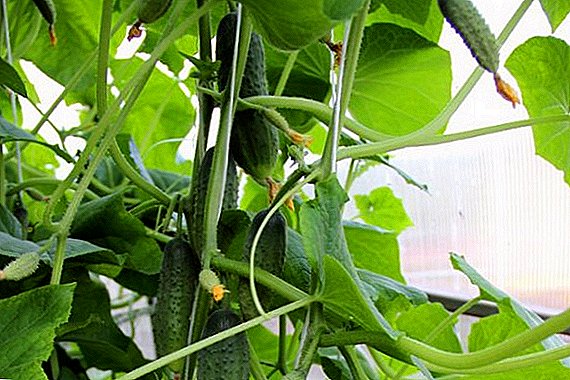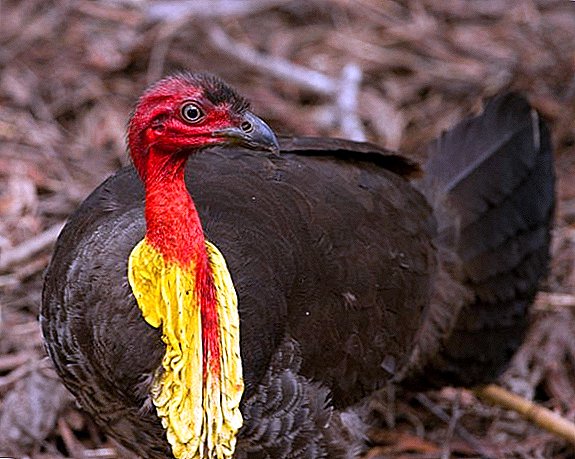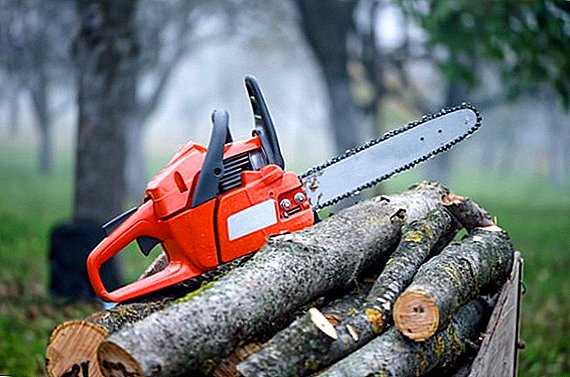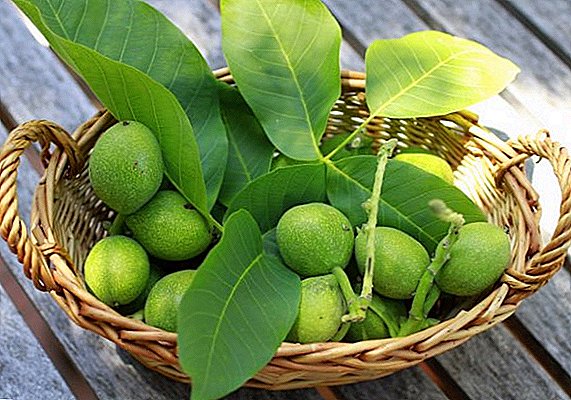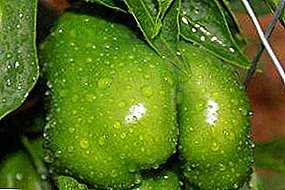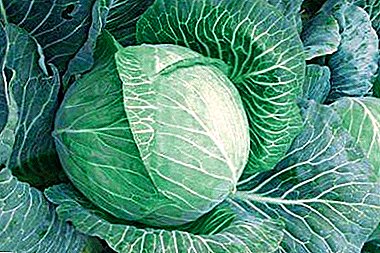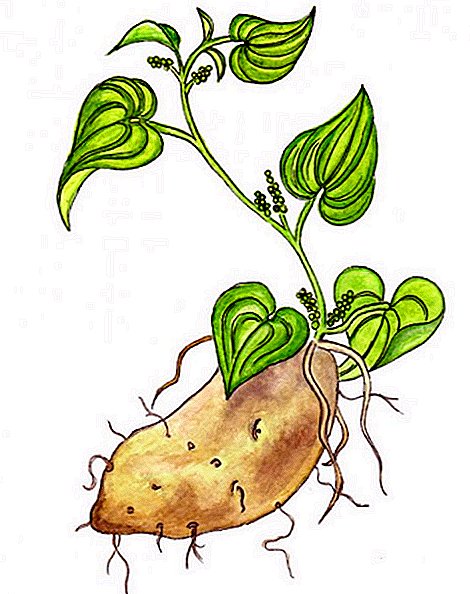 In modern suburban areas, you can find almost any plants, and both familiar to our area, and very exotic. Many of them have similar structural features, which makes it possible to better understand the needs of the culture when it is grown. In this article we want to pay attention to the tuberous varieties presented in the form of both flower and vegetable crops.
In modern suburban areas, you can find almost any plants, and both familiar to our area, and very exotic. Many of them have similar structural features, which makes it possible to better understand the needs of the culture when it is grown. In this article we want to pay attention to the tuberous varieties presented in the form of both flower and vegetable crops.
What is a tuber
Tuber is called thickened and modified root - the underground stem shoot of some plants. It has dormant buds, usually with one or more internodes (for example, like potatoes or Jerusalem artichoke), or a dense subfloor knee (a bright representative is cyclamen).
Tuberous plants are represented by the most diverse species, but the largest group is represented by flowers, among which are perennials and annuals, indoor and wild specimens. In addition, tuberous plants can be divided into species based on the characteristics of the underground part. There is usually talk about the roots and tubers.
Culver plants
A root can have different sizes and shapes, but in any case it remains modified by a root, with a large supply of nutrients. From ordinary tubers, root crops are distinguished by the absence of dormant buds, usually located on the root collar.  The most popular plants in this group can be considered dahlia and begonia. This underground part is also characteristic of chiselle, Jerusalem artichoke, potato, sweet potato, cassava.
The most popular plants in this group can be considered dahlia and begonia. This underground part is also characteristic of chiselle, Jerusalem artichoke, potato, sweet potato, cassava.
Bulbotuber plants
Corm - the same underground part of the plant, but only presented in the form of an underground stem, with well-marked knotty rings and buds of different sizes, located in the upper part of the corm. From the outside, it is covered with small scales, that is, dried leaf buds.
These plants include gladiolus, autumn crocus and crocus. Outwardly, all their underground parts resemble both a tuber and an onion at the same time, but the fleshy part has a stem origin: the flowering stem emerges from just such a bulb.  Based on the location of bulbous scales, two types of bulbs can be distinguished: filmy (“leaves” cover each other tightly and completely like a tulip) and tiled (for example, lilies, in which the rhizomatous part resembles a tiled surface).
Based on the location of bulbous scales, two types of bulbs can be distinguished: filmy (“leaves” cover each other tightly and completely like a tulip) and tiled (for example, lilies, in which the rhizomatous part resembles a tiled surface).
Important! There are several variants of modified shoots, and, in addition to this, you can also select the protective spines and antennae in the axils of the leaf plates (serve to keep plants on the support), as well as whips (above-ground shoots covering the soil surface).
Tuberous flowers
As we have already mentioned, flowers are the largest group of tuberous plants. Some of them grow in gardens, others perform a decorative function in the premises, but they all share a fleshy and powerful root part. Let's learn more about the most popular of these plants, their external features and requirements for care. 
Garden
Dahlias, begonias and anemones are considered the most popular garden flowers in private territories today, although Crocosmia and Crested Flags are common. About them and will be discussed further.
Anemone
Anemone (this is also called this flower) belongs to the genus of perennial herbaceous plants of the Buttercup family. In the northern hemisphere of our planet, all representatives of 120 species are found almost everywhere, with the exception of tropical zones.
We advise you to get acquainted with the popular types of anemones, as well as learn how to use the anemone in traditional medicine.

The main features of anemones include the following features:
- in addition to the thickened tuber-like rhizome, the plant has upright stem parts, reaching a height of 100 cm;
- usually stems are leafless, and at their end there is a flower stalk with a half-capped inflorescence or just one flower;
- palmate or finely dissected leaves are collected in the rosette;
- on flowers there are numerous pistils and stamens, as well as from 5 to 20 petals of different shapes and colors;
- the anemone can be yellow, red, white, pink, blue or blue;
- flowering begins in early spring and continues throughout the summer, sometimes lingering even in the fall;
- fruit - leaflet.

In the wild, anemone can be found in forest plantations, steppes and meadows, and some species have found a place for themselves even in the Arctic. If desired, it is easy to find and decorative forms.
Planting such a plant on your site, do not forget that among the varieties emit both light and shade specimens. If you plant it in an inappropriate place, then do not count on abundant and prolonged flowering.
Learn more about what types of soil exist, how to improve soil fertility, how to independently determine the acidity of the soil at the site, as well as how to deoxidize the soil.
The best option would be a plot with neutral acid soil and an optimal moisture level. Waterlogging is detrimental to the underground part, while the lack of moisture will negatively affect the appearance of the flower.
Video: landing anemones The solution to the problem will be planting on high ground and arranging drainage or mulching the upper layer of soil. Of the fertilizers anemone fit complex mineral compounds that are applied to the soil mainly during the flowering period. For the winter, you can leave the anemone without shelter, it tolerates cold.
Did you know? Flowers described plants are widely used in traditional medicine, as they are able to relieve cramps and stress. However, their attractive appearance is deceptive, and if they get inside the human body, they can cause severe poisoning.
Begonia
This flower looks a lot like a little rose. Its flowers are neat and graceful, and the flowering is quite abundant (during the whole season the plant is literally strewn with them). Begonia is a perennial shrub that, in addition to the tuber, has other remarkable features.  For example, in the wild, the “home” for a plant is not the soil, but the trunks of trees, although in garden conditions it is still small bushes (up to 20 cm) growing on the ground. Sometimes you can meet quite tall representatives, reaching a height of 35 cm.
For example, in the wild, the “home” for a plant is not the soil, but the trunks of trees, although in garden conditions it is still small bushes (up to 20 cm) growing on the ground. Sometimes you can meet quite tall representatives, reaching a height of 35 cm.
Today, there are about 1,200 varietal variations of garden begonias, among which terry specimens of various colors are distinguished by special beauty: white, pink, yellow, red, lilac. On the round leaf plates, you can see fancy patterns, which are inherent only in indoor plants.
It is not difficult to care for the flower: the gardener only needs to periodically loosen the soil and provide abundant watering (during active growth and development, the regularity of introducing the liquid should be at least 1 time in 3 days).
Video: the basics of successful begonia care Spraying begonia is not necessary, otherwise all the decorativeness of its leaves will be lost. After flowering and watering, and any other care completely stopped.
Familiarize yourself with the nuances of growing such types of begonias, such as coral begonia, elator, Bolivian, ampelous, royal, tuberous.
Dahlia
The familiar beauty of dahlia belongs to the root and tuber plants. Every year its above-ground part dies off, and under the ground powerful rootstocks appear, which contain a large supply of nutrients for new active growth of the kidneys.
Important! In average climatic conditions it is not necessary to leave the tubers for the winter in the ground, because, most likely, they will freeze and die.
In the new season of the growth buds located on the root neck of the plant, again there will be stems with flowers. 
In the general description of the plant should pay attention to its features:
- The stem part of dahlias is large, the stems grow from 25 cm to 3 m in height, and the latter need an obligatory garter and additional support.
- Inflorescences are represented by baskets with a diameter of 3-30 cm. All of them consist of a set of tubular and reed petals.
- Reed flowers can have the most diverse colors, they set the overall appearance of the flower.
- Tubular flowers are located in the central part and are usually colored yellow or orange.
It will be helpful for you to read about how to grow annual and perennial dahlias on your plot, how to keep dahlia tubers in winter, and when and how to plant dahlias in open ground.
Among all the species diversity of dahlias in suburban areas, the most common are simple (non-double-coated), collar (bushes grow up to two meters), peony, spherical, and pompon. All of them have large flowers, which will become a real decoration of your garden.  It is easy to care for dahlias, the main thing is to organize timely watering and ensure regular feeding (3 times per season the bushes are poured with slurry, in a ratio of 1:10, and also fertilize the plants with urea: 60 g of substance are enough for 10 liters of water).
It is easy to care for dahlias, the main thing is to organize timely watering and ensure regular feeding (3 times per season the bushes are poured with slurry, in a ratio of 1:10, and also fertilize the plants with urea: 60 g of substance are enough for 10 liters of water).
In addition, it will be useful to weed the bushes several times over the summer and loosen the ground beneath them, and to obtain large beautiful inflorescences it is advisable to step the plants.
Crocosmia
Montbrecia (the second name of the flower) is an excellent plant for flower beds and a garden, as it is characterized by abundant and long flowering throughout the summer and even to the most frost. Cut flowers stand perfectly for two weeks. If we consider the plant from a botanical point of view, it belongs to the Iris family.
Did you know? The aroma of crocosmia will not leave anyone indifferent. If you dry her petals, then by their smell they will resemble saffron.

The genus includes not too many varieties, about 50, but as for the Crocosmia, the features of its structure are expressed in the following:
- The underground part of the montrebice is represented by corms, with 2-3 layers of mesh shells. Of them, there is a long stem part, reaching 60-90 cm in height.
- Leaf plates are very similar to the leaves of the iris and are collected in a tight fan. Glossy leaves in the form of a sword appear from the central part of the bulb, just like the stems.
- On one adult plant there are from three to four shoots that play the role of peduncle.
- Paniculate inflorescences form from the numerous lily flowers in the upper part of the stem. Crocosmia bloom can be observed from July until the end of September, of course, if you do not have to face the early frosts.
Montbrecia is extremely unpretentious in care, therefore, when grown in open soil, there will be no problems with it. After dropping it in a warm place in April (the temperature of the soil should reach at least + 6 ... +10 ° C), you need to water the flower well, regularly repeating the procedure for lush and abundant flowering.  Dry soil leads to a loss of decorativeness, so you should constantly keep it wet. In rainy weather, watering is reduced or canceled altogether, and so that the water does not stagnate, it is useful to regularly loosen the soil near the root system.
Dry soil leads to a loss of decorativeness, so you should constantly keep it wet. In rainy weather, watering is reduced or canceled altogether, and so that the water does not stagnate, it is useful to regularly loosen the soil near the root system.
You can begin to fertilize the plant from early spring. In April - June, for these purposes, mullein is used, combined with nitrogen supplements (an aqueous solution is prepared in a ratio of 1:10).
It is better to alternate the use of mineral and organic substances, and as soon as the first buds appear on the plant, it is recommended to completely eliminate nitrogenous fertilizers.
Crested
The crested hen is a representative of a large genus of herbs, the Poppy family, which are widely distributed in temperate climatic zones. All members of this genus are mostly perennials, but among them there are annual varieties.  The leafy plates of the crested hen resemble ferns; they are double or even triplicate. Inflorescences are a brush or single flowers placed on long peduncles (the nectar accumulated in them is available only by insects with a long proboscis).
The leafy plates of the crested hen resemble ferns; they are double or even triplicate. Inflorescences are a brush or single flowers placed on long peduncles (the nectar accumulated in them is available only by insects with a long proboscis).
The fruit of the plant is a pod-like dry box. Thanks to the tuberous root, which contains a good supply of nutrients, with the advent of spring, you can observe the vegetation of the plant. As for the spread of seeds, ants play a significant role in this.
Read more about the features of planting and caring for the crested hen.
Tuber crested tubercules feel equally well both in the sun and in shady areas, with light, nutritious and loose soil. Plants look great in the overall composition with primroses and other perennial plants, and are also suitable for decorating tree trunks of other green inhabitants of the summer cottage.
Video: description of tuberous plant crested Crested birds are not afraid of frost, are resistant to diseases, and of the pests they are afraid of only moles and mice. Watering, as well as top dressing, can be done several times a season, during drought - more often.
Room
Indoor ornamental plants are grown primarily in pots, which allows for good and abundant flowering at any time of the year. Among the tuberous representatives of this group, ginger, playon and gemantus are distinguished, which are distinguished by high decorative properties. Consider each of them.
Ginger
Ginger is a perennial plant of the Ginger family. People are more familiar with its root, but connoisseurs of the aboveground part are also found, which, if properly combined with other vegetation, can become a real decoration of a room or garden.  Upright, rounded stalks of ginger reach 1–1.5 m in height, although bushes 30–40 cm in height are more valuable for decorative breeding. Flower stems have a scaly structure, leaves - lanceolate, entire, arranged alternately.
Upright, rounded stalks of ginger reach 1–1.5 m in height, although bushes 30–40 cm in height are more valuable for decorative breeding. Flower stems have a scaly structure, leaves - lanceolate, entire, arranged alternately.
Flowers - orange-yellow or brownish, resemble spike. The fruit is represented by a tricuspid box, and the rhizome is made up of fleshy roundish palchatotrazdelyazhennymi parts, of which created the entire root system.
Did you know? In some countries, ginger is called "Zingiber", which is supposedly translated as "horned root".
The main task in growing indoor ginger is to find the right place for it. This plant prefers well-lit areas, but without constant exposure to direct sunlight.
Video: planting ginger Given the tropical origin, its watering should be regular, with an increase in intensity in particularly dry times and a decrease at low temperatures. Ginger doesn’t prevent regular spraying.
You will probably be interested to read about the beneficial properties of ginger, as well as learn how to plant and grow ginger in the garden and pot.
How exactly your ginger will look like in an adult depends on the purpose of its cultivation. If the grower needs a root, then the leaves can not be cut, because after 8-9 months they will dry out and you can safely reach the underground part (the root is dried and stored in a dark and cool place).
When an ornamental plant is grown, it is planted in a small pot, and after the leaves dry out, the root part is left in the soil. This goes on for several years.  Unlike many other indoor plants, ginger even during the winter rest requires a slight soil moisture, and in spring, after waking up, the amount of applied liquid is increased, adding fertilizer for indoor flowers to it (previously mixed with potassium).
Unlike many other indoor plants, ginger even during the winter rest requires a slight soil moisture, and in spring, after waking up, the amount of applied liquid is increased, adding fertilizer for indoor flowers to it (previously mixed with potassium).
Did you know? Both indoor varieties of gemantus have a positive effect on the health of their owners. The pressure of the people in the room is normalized and the metabolic processes in the body improve. It is especially useful to place a flower pot next to electrical engineering (it absorbs harmful radiation).
Playone
This miniature ornamental plant grows no more than 30 cm in height and belongs to the Orchid family. The genus includes both epiphytic (grow on other plants) and lithophytic (grow on a rocky surface) forms of flowers, although land members of the family remain the most common in domestic cultivation. 
Observing the development process of a plant, it is easy to note its botanical features:
- At the beginning of the growing season, 1-2 hard oval leaves, dark green appear over the tuber. Leaf plates grow to a length of 10-15 cm long. Some representatives of the playon bloom in early spring or autumn and by the beginning of this period, a short peduncle is formed at the base of the tuberous rhizome, with 1-3 buds on an even stem part.
- The diameter of the fully opened flowers is about 6-11 cm, and each of them does not lose its attractiveness for the whole month.
- The color of flowers varies from white and cream to yellow and crimson and is clearly visible on the fanned petals. The lip looks like a tube or spindle, with an extended fringed edge.

Even beginner flower growers can grow the playon: when placed in the eastern or western part of the apartment, where a sufficient amount of light constantly falls, there will be no problems with it.
Предварительно растение высаживают в неглубокую ёмкость, на дне которой организованы большие отверстия для стока воды, с обязательным использованием дренажного слоя (с этой ролью идеально справятся керамзит и галька).
As a substrate for planting, you can use a soil mixture of small pine bark, peat moss and charcoal. Immediately after disembarking, it is necessary to lower the temperature in the room to + 10-15 ° C.
Important! Domestic playones need to be transplanted annually in early spring, and performing this task should be replaced with more upper part of the substrate and examine the roots for signs of any diseases.
Video: Playon Care Rules Abundant watering is necessary for the plant only during the growing season, and after the leaves are dropped, the introduction of liquid is almost completely stopped. The ideal humidity in the room is 50%, although in the heat it is increased to 70%.
Top dressing is applied to the soil every month, starting in April and ending in mid-autumn, until the leaves fall. Nutritional formulations for orchids are excellent for the role of fertilizer.
Gemantus
Gemantus is a representative of the bulbous bulbous plants of the Amaryllis family. Some species shed their leaves for the winter, while others always remain evergreen, so that they are more often chosen than others for home cultivation.
The most popular indoor species are the gematus of Katharina and the white-flowered evergreen gemantus, often referred to as the "elephant's ear" or "bull's tongue." External features of these plants are due to their species. 
For example, "Katharine" has the following botanical characteristics:
- clearly visible elongated, slightly wavy leafy plates, placed on a 15-centimeter pseudostem;
- the flower forms on the arrow that appears next to the false stem (the flowers of the plant are predominantly red, and the inflorescence resembles a large ball);
- after flowering in place of the flowers, a berry-like fruit appears, from which, if necessary, seeds can be obtained.
The white-flowered representative has dense and wide oval leaflets, smooth in the central part and hairy at the end. The plant is characterized by a more dense inflorescence, with white flowers and hard anthers. From above, they look as if they were sprinkled with yellowish powder.
Learn more about the cultivation and reproduction of gemanthus.
In comparison with the hematus of Katharina, the white-flowered species has a thick and short peduncle. Flowering can be observed in July - August, and in early autumn there are fruits that ripen around mid-November (at this time the boxes turn bright red or orange).  Seeds are suitable for further reproduction. As for the features of care, gemanthus requires good lighting, but with protection from the direct rays of the sun. The room temperature should be kept at + 18 ... +22 ° C in summer and + 12 ... +15 ° C - in winter.
Seeds are suitable for further reproduction. As for the features of care, gemanthus requires good lighting, but with protection from the direct rays of the sun. The room temperature should be kept at + 18 ... +22 ° C in summer and + 12 ... +15 ° C - in winter.
Watering is plentiful in a drought (with obligatory draining of drains from a pallet), and the next time they apply liquid to the soil only when the upper layer dries 1-2 cm. In winter, you can slightly moisten the soil in the pot, but not often.
Plant nutrition is performed once every 2-3 weeks and only during active growth and development. For these purposes, you can use both organic and mineral compounds. Hemantus transplants are practiced once every 2-3 years.
Video: the secrets of caring for gemantius
Potato tuber
Potatoes - one of the most popular plants, the tubers of which are widely used for culinary purposes. They are highly nutritious and are used to prepare a variety of dishes. Any summer resident will probably be interested to learn more about potato tubers.
How to form a tuber
As we mentioned earlier, the tuber is the result of the thickening of the underground part of the stem shoot - the stolon. There are no normally developed leaves on it, and in the sinuses of the modified and atrophied leaf plates are the so-called eyes.
Stolons appear on the plant when it reaches 20 centimeters in height, and during its development, the upper part thickens and grows, becoming a familiar potato tuber, covered with tender skin.  In the future, the potato rind only thickens and no longer lets as much air as before. From this point on, the function of removing moisture and the "breath" of a tuber is entirely assigned to lentils scattered across the entire surface of the potato.
In the future, the potato rind only thickens and no longer lets as much air as before. From this point on, the function of removing moisture and the "breath" of a tuber is entirely assigned to lentils scattered across the entire surface of the potato.
Potato tubers can have the most varied forms (elongated, rounded, re-shaped, etc.), due to specific growing conditions and varietal characteristics of the plant. Surface-mounted eyes are classified as superficial, small, medium and deep.
In culinary needs, they usually use small-eyed tubers, since they are very easy to wash and clean. The maximum growth of the underground part of the potato coincides with the flowering of the plant. Increasing in size, the cells of the tuber accumulate moisture, nutrients and carbohydrates (up to 75% of the final value).  This period (approximately 45-60 days from the beginning of flowering) can even be called critical for crop formation and, if growth conditions turn out to be inappropriate (for example, there is not enough moisture and fertilizer), then you can not hope for a bountiful harvest.
This period (approximately 45-60 days from the beginning of flowering) can even be called critical for crop formation and, if growth conditions turn out to be inappropriate (for example, there is not enough moisture and fertilizer), then you can not hope for a bountiful harvest.
Tuber structure
A longitudinal section of a ripe potato will clearly show its main constituent parts: the epidermis (skin), bark, cambium, vascular fibers, and the core. The skin performs a protective function and combines several rows of periderm cells that have been screened.
Under this layer is the crust, consisting of parenchymal cells, which contain grains of starch. Below that is the cambium layer, from which xylem elements stretch to the center. The central part of the potato contains parenchymal medullary cells.  Based on the variety, 3-15 peepholes are formed on the modified underground shoots. There are 3-4 buds in each of them: one main and several sleepers (they begin to grow only when the main section is cut or broken, but the plants formed from them will no longer be so dense). In size and degree of differentiation, the eyes differ from each other, but on the upper, youngest part of the tuber, there are always more of them.
Based on the variety, 3-15 peepholes are formed on the modified underground shoots. There are 3-4 buds in each of them: one main and several sleepers (they begin to grow only when the main section is cut or broken, but the plants formed from them will no longer be so dense). In size and degree of differentiation, the eyes differ from each other, but on the upper, youngest part of the tuber, there are always more of them.
The nutritional value of potato tubers is characterized by the following indicators (per 100 g):
- calorie - 77 kcal;
- proteins - 2 g;
- fats - 0.4 g;
- carbohydrates - 16.3 g;
- dietary fiber - 1.4 g;
- water - 78.6 g;
- starch - 15 g;
- saturated fatty acids - 0.1 g;
- mono - and disaccharides - 1.3 g
Learn more about the beneficial properties of potatoes, its flowers, as well as why you should not throw away potato peelings.

Important! You should not eat sprouted green potatoes, because in this state it contains a large amount of a toxic substance called solanine.
Diseases
Despite the fact that many gardeners consider potatoes an unpretentious plant, with the wrong agricultural technology there is every chance of developing diseases. Any disease significantly reduces the value of tubers, so the fight against them must begin at the slightest sign.
We recommend that you familiarize yourself with the methods of controlling diseases and pests of potatoes.
The most common ailments of potatoes include:
- Late blight (manifested by lead-gray or brown spots on the peel). Most often occurs immediately after placing the potatoes in storage, at relatively high temperature indices.
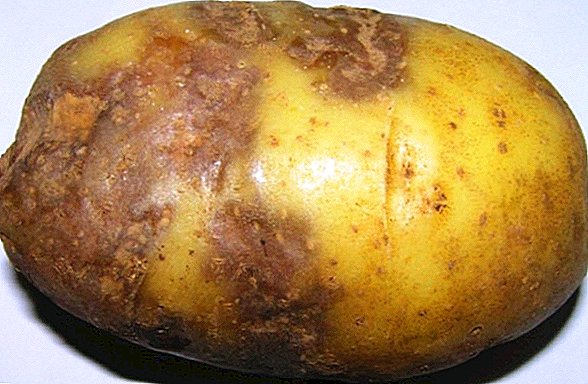
- Alternaria (depressed, uneven spots, which differ in color from healthy skin) are well visible on the entire surface. Soon they may appear wrinkled, and under them a dark dry mass is formed.
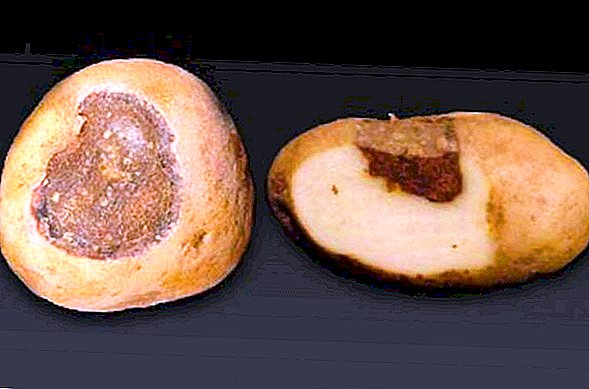
- Black scab it manifests itself in black flat lumps that resemble ordinary dried soil adhering to potatoes. A severe fungal infection is manifested by covering almost the entire tuber. The plant can become infected during active growth, and rapid development is more often observed during a long spring and late harvest.

- Fusarium Dry Rot. It may occur during any storage period, but most of the signs are noted closer to the middle or end of storage. At the beginning of its development, the disease appears dull, gray-brown specks, and a little later the flesh under them dries out and melts. In the affected parts of the tuber voids are formed, filled with mycelium.

- Strangulation, freezing and deformation of tubersassociated with improper cultivation or storage. In the first case, the cause of this phenomenon may be an acute lack of oxygen in the storage, in the second - a decrease in temperature to -2 ° C or even lower, and in the third - a violation of suitable conditions during the growing season (for example, when prolonged droughts begin ).
All these are only the main, the most characteristic diseases for potatoes, but in fact there are dozens of them. So, often the tubers are affected by ordinary or powdery scab, rubber rot, ring rot, black stalk (infection occurs in almost any conditions: during growth and during storage), brown bacterial rot.
In addition, violation of the conditions for the collection and transportation of potatoes can lead to the appearance of gray or glandular spotting, darkening of the flesh, and hollowness.
Video: varieties, diseases and potato harvesting It is much easier to prevent illnesses than to deal with their consequences, therefore, when growing potatoes, it is necessary to comply with the treatment of plants with fungicides and to take care of appropriate storage conditions in advance.
Each tuberous plant has its own individual and unique features and can be used for a variety of purposes.
Let the tuber is just another kind of underground part of the plant, but the correct planting and cultivation of the same potato, with knowledge of the specificity of the process of tuberization, will certainly bring only positive results. Therefore, if you want to get the maximum yield, it is better to carefully study this issue.






